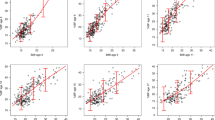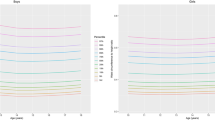Abstract
Background:
Adiposity and health risks are better indicated by waist circumference than body mass index (BMI). Patterns of change with age are incompletely documented.
Methods:
Adults aged 18–92 years in the Scottish and English Health Surveys of 1994–96 and 2008–10 were divided into fifteen 5-year age bands. Sex-specific prevalences of overweight/obesity and of increased/high waist circumference against age were compared using analysis of covariance.
Results:
Data available for 7932 Scottish and 55 925 English subjects in 1994–96, and for 27 391 Scottish and 30 929 English in 2008–10, showed generally similar patterns of change in the two countries. Prevalences of both elevated BMI and waist circumference rose with age for longer in 2008–10 than in 1994–96, reaching higher peaks at greater ages, particularly among men. Between 1994–96 and 2008–10, maximum prevalences of BMI>30 increased from 25 to 38% (larger increases in men than women), reaching a peak at age 60–70 years in both sexes. This peak prevalence was 5–10 years later than in 1994–96 for men and remained unchanged for women. Between 1994–96 and 2008–10, maximum prevalences of high waist circumference (men>102 cm, women>88 cm) increased from 30 to –70% in both sexes, peaking in 2008–10 at ages 80–85 years (men) and 65–70 years (women). In 2008–10, proportions of adults with ‘normal’ BMI (18.5–25) fell with age to 15–20% at age 60–70 years (men) and 75 years (women). Among all those with BMI=18.5–25, aged>65 years, the proportions with unhealthily elevated waist circumference were 30 (men>94 cm) and 55% (women>80 cm).
Conclusions:
Almost 40% of men and women are now becoming obese. People are growing fatter later in life, with waist circumference rising more persistently than BMI, which may indicate increased loss of muscle mass and sarcopenia in old age. Among older people, few now have ‘normal’ BMI, and of these up to half have elevated waist circumference, raising questions for the suitability of BMI as a measure of adiposity in this age group.
This is a preview of subscription content, access via your institution
Access options
Subscribe to this journal
Receive 12 print issues and online access
$259.00 per year
only $21.58 per issue
Buy this article
- Purchase on Springer Link
- Instant access to full article PDF
Prices may be subject to local taxes which are calculated during checkout





Similar content being viewed by others
References
Flegal KM, Carroll MD, Kit BK, Ogden CL . Prevalence of obesity and trends in the distribution of body mass index among US adults, 1999–2010. J Am Med Assoc 2012; 307: 491–497.
Han TS, Sattar N, Lean M . ABC of obesity. Assessment of obesity and its clinical implications. BMJ 2006; 333: 695–698.
Hendriks AM, Gubbels JS, De Vries NK, Seidell JC, Kremers SP, Jansen MW . Interventions to promote an integrated approach to public health problems: an application to childhood obesity. J Environ Public Health 2012; 2012: 913236.
Ogden CL, Carroll MD, Curtin LR, Lamb MM, Flegal KM . Prevalence of high body mass index in US children and adolescents, 2007–2008. JAMA 2010; 303: 242–249.
Hughes VA, Roubenoff R, Wood M, Frontera WR, Evans WJ, Fiatarone Singh MA . Anthropometric assessment of 10-y changes in body composition in the elderly. Am J Clin Nutr 2004; 80: 475–482.
Janssen I . Morbidity and mortality risk associated with an overweight BMI in older men and women. Obesity (Silver Spring) 2007; 15: 1827–1840.
Flegal KM, Graubard BI, Williamson DF, Gail MH . Excess deaths associated with underweight, overweight, and obesity. JAMA 2005; 293: 1861–1867.
Stevens J, Cai JW, Pamuk ER, Williamson DF, Thun MJ, Wood JL . The effect of age on the association between body-mass index and mortality. N Engl J Med 1998; 338: 1–7.
Flegal KM, Kit BK, Orpana H, Graubard BI . Association of all-cause mortality with overweight and obesity using standard body mass index categories: a systematic review and meta-analysis. JAMA 2013; 309: 71–82.
Health and Social Care Information Centre LS. Statistics on Obesity, Physical Activity and Diet: England 2013.
Locher JL, Roth DL, Ritchie CS, Cox K, Sawyer P, Bodner EV et al. Body mass index, weight loss, and mortality in community-dwelling older adults. J Gerontol A Biol Sci Med Sci 2007; 62: 1389–1392.
Han TS, Tajar A, Lean MEJ . Obesity and weight management in the elderly. Br Med Bull 2011; 97: 169–196.
Lean ME, Han TS, Deurenberg P . Predicting body composition by densitometry from simple anthropometric measurements. Am J Clin Nutr 1996; 63: 4–14.
Visscher TLS, Seidell JC, Molarius A, van der Kuip D, Hofman A, Witteman JCM . A comparison of body mass index, waist-hip ratio and waist circumference as predictors of all-cause mortality among the elderly: the Rotterdam study. Int J Obes Relat Metab Disord 2001; 25: 1730–1735.
Mindell J, Biddulph JP, Hirani V, Stamatakis E, Craig R, Nunn S et al. Cohort profile: the health survey for England. Int J Epidemiol 2012; 41: 1585–1593.
Lean ME, Katsarou C, McLoone P, Morrison DS . Changes in BMI and waist circumference in Scottish adults: use of repeated cross-sectional surveys to explore multiple age groups and birth-cohorts. Int J Obes (Lond) 2012; 37: 800–808.
World Health Organisation. Obesity: preventing and managing the global epidemic. Report of a WHO consultation. World Health Organ Tech Rep Ser 2000; 894, i-xii, 1–253.
Lean MEJ, Han TS, Morrison CE . Waist circumference as a measure for indicating need for weight management. Br Med J 1995; 311: 158–161.
Ding J, Kritchevsky SB, Newman AB, Taaffe DR, Nicklas BJ, Visser M et al. Effects of birth cohort and age on body composition in a sample of community-based elderly. Am J Clin Nutr 2007; 85: 405–410.
Eiben G, Dey DK, Rothenberg E, Steen B, Bjorkelund C, Bengtsson C et al. Obesity in 70-year-old Swedes: secular changes over 30 years. Int J Obes (Lond) 2005; 29: 810–817.
Droyvold WB, Nilsen TI, Kruger O, Holmen TL, Krokstad S, Midthjell K et al. Change in height, weight and body mass index: longitudinal data from the HUNT Study in Norway. Int J Obes (Lond) 2006; 30: 935–939.
Stenholm S, Simonsick EM, Ferrucci L . Secular trends in body weight in older men born between 1877 and 1941: the Baltimore Longitudinal Study of Aging. J Gerontol Ser A Biol Sci Med Sci 2010; 65: 105–110.
Lean MEJ, Han TS, Seidell JC . Impairment of health and quality of life in people with large waist circumference. Lancet 1998; 351: 853–856.
Etman A, Burdorf A, Van der Cammen TJM, Mackenbach JP, Van Lenthe FJ . Socio-demographic determinants of worsening in frailty among community-dwelling older people in 11 European countries. J Epidemiol Community Health 2012; 66: 1116–1121.
Gobbens RJJ, van Assen MALM, Luijkx KG, Wijnen-Sponselee MT, Schols JMGA . Determinants of frailty. J Am Med Dir Assoc 2010; 11: 356–364.
Flegal KM, Graubard BI, Williamson DF, Gail MH . Cause-specific excess deaths associated with underweight, overweight, and obesity. JAMA 2007; 298: 2028–2037.
McGee DL . Body mass index and mortality: a meta-analysis based on person-level data from twenty-six observational studies. Ann Epidemiol 2005; 15: 87–97.
Han TS, Lean ME . Self-reported waist circumference compared with the ‘Waist Watcher’ tape-measure to identify individuals at increased health risk through intra-abdominal fat accumulation. Br J Nutr 1998; 80: 81–88.
Han TS, McNeill G, Seidell JC, Lean ME . Predicting intra-abdominal fatness from anthropometric measures: the influence of stature. Int J Obes Relat Metab Disord 1997; 21: 587–593.
Wannamethee SG, Shaper AG, Whincup PH, Walker M . Characteristics of older men who lose weight intentionally or unintentionally. Am J Epidemiol 2000; 151: 667–675.
Acknowledgements
AV is in receipt of a scholarship from the Yorkhill Children’s Foundation. We thank Jeremy Jones for his helpful comments and insights.
Author information
Authors and Affiliations
Corresponding author
Ethics declarations
Competing interests
The authors declare no conflict of interest.
Additional information
Supplementary Information accompanies this paper on International Journal of Obesity website
Supplementary information
Rights and permissions
About this article
Cite this article
Vlassopoulos, A., Combet, E. & Lean, M. Changing distributions of body size and adiposity with age. Int J Obes 38, 857–864 (2014). https://doi.org/10.1038/ijo.2013.216
Received:
Revised:
Accepted:
Published:
Issue Date:
DOI: https://doi.org/10.1038/ijo.2013.216
Keywords
This article is cited by
-
Prediction of body fat in adolescents: validity of the methods relative fat mass, body adiposity index and body fat index
Eating and Weight Disorders - Studies on Anorexia, Bulimia and Obesity (2022)
-
Body mass index trend and variability in rheumatoid arthritis
Clinical Rheumatology (2022)
-
Brown adipose tissue fat-fraction is associated with skeletal muscle adiposity
European Journal of Applied Physiology (2022)
-
Effect of body mass on future long-term care use
BMC Geriatrics (2020)
-
Socioeconomic inequality in abdominal obesity among older people in Purworejo District, Central Java, Indonesia – a decomposition analysis approach
International Journal for Equity in Health (2017)



